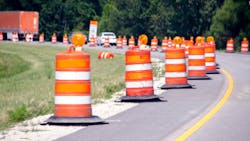Here’s the good news: With the bipartisan Infrastructure Investment and Jobs Act now signed into law, more federal dollars will flow to road construction, expansion, and repair across the country. As the winter weather gives way to spring, we’ll begin to see the familiar orange cones and barrels that should symbolize progress.
Here’s some more good news: National Work Zone Awareness Week is April 11-15, which is worth noting because we can all use a reminder now—at the start of road construction season—to exercise extra care when trucking through work zones.
See also: When it comes to safety, make the investment
It’s a sad fact, but work-zone accidents and fatalities continue to increase. In 2019, the last full year for such statistics, there were 762 crashes with 842 fatalities in work zones nationwide. Those numbers represent, respectively, a 9.8% and a 7.6% increase over the previous three-year average.
Trucks were involved in 247 of those work-zone crashes, 288 of which involved fatalities. Truck-involved crashes were up 19.5% over the three-year average, while truck-involved fatalities grew 16.5%. And now, the welcome infusion of fresh federal money may bring even more work zones this year.
As truck fleet managers, as law enforcement personnel, and as ordinary highway users, we all know the reasons that work zones can be dangerous. They slow our travel. They introduce narrow lanes, slower posted speeds, abrupt curves, and even stopped traffic where free-flowing, higher speeds once existed. Work zones also may bring the unexpected—workers and machinery right there in front of us. They can frustrate the impatient driver. Orange may mean “slow down,” but some drivers see red.
Here are seven tips to trucking safely through work zones, so tell your drivers:
- Read the signs. Work-zone signs tell you changes in the normal traffic pattern are ahead. Pay attention.
- Keep your distance. Leave enough space between your truck and the vehicle ahead of you. Be prepared to slow down or stop unexpectedly.
- Obey reduced speed limit signs. Stopping is easier when traveling at or below the recommended work-zone speed limit. Be ready to slow or stop by keeping your speed in check.
- Merge safely and early. When work zones require lane changes, move into the open lane at your earliest safe opportunity. Watch your “blind spots,” as other vehicles may speed up to get in front of you.
- Signal to others what’s ahead. You sit up higher in the cab. When you see slowing or stopped traffic, turn on your flashers to signal traffic behind you.
- Watch out for workers. A highway work zone means workers and their machinery may enter your traffic lane, sometimes abruptly. Your complete attention is the best defense against accidents.
- Be patient. A work zone is a sign of improvement—smoother pavement, safer routing, stronger bridges in the future. Take your time. That “End Road Work” sign in the distance is a “thank you” for being a safe and courteous truck driver.
National Work Zone Awareness Week is just the start of road construction season. Let’s make it safer than ever before!
Steve Vaughn is VP of field operations at PrePass Safety Alliance, the provider of PrePass weigh station bypass and toll-payment and management services. Vaughn served nearly three decades with the California Highway Patrol and is a past president of the Commercial Vehicle Safety Alliance.
About the Author
Steve Vaughn
Senior Vice President of Field Operations
Steve Vaughn is senior vice president of field operations at PrePass Safety Alliance, the provider of PrePass weigh station bypass and electronic toll-payment and management services. Vaughn served nearly three decades with the California Highway Patrol and is a past president of the Commercial Vehicle Safety Alliance.
